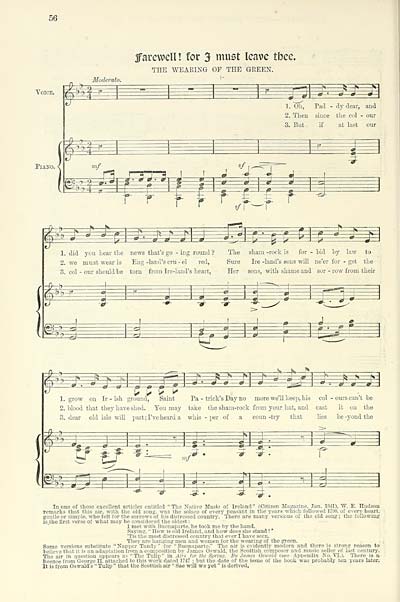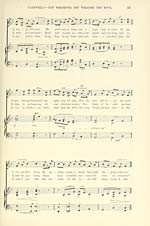Glen Collection of printed music > Printed music > Minstrelsy of Ireland
(74) Page 56 - Farewell! For I must leave thee
Download files
Complete book:
Individual page:
Thumbnail gallery: Grid view | List view

56
Toice.
Piano.
farewell ! for 3 must leave tfoee.
THE WEARING OP THE GREEN.
Moderato.
1. Oh, Pad - dy dear, and
2. Then since the col - our
3. But if at last our
±±~3-
ZjjjJ-
:t*=
=JC
3EZ3t
fz=
1. did you hear the news that's go - ing round ? The
2. we must wear is Eng -land's era - el red, Sure
3. col - our should he torn from Ire-land's heart, Her
sham -rock is for - bid by law to
Ire -land's sons will ne'er for - get the
sons, with shame and sor - row from their
6=^
szqszrps
~0Z
0-
3*
^=^1
-wt—w-
sround,
Saint
1. grow on Ir - ish ground, Saint Pa - trick's Day no more we'll keep, his col - ours can't be
2. blood that they have shed. You may take the sham-rock from your hat, and cast it on the
3. dear old isle will part; I've heard a whis - per of a coun -try that lies be-yondthe
K\=\-
q=
tV^f^-
3
s
3rj^r
i W -m-
m -r-
~mr
tnf
&-
--!-
BfeS
:zz
c
3t
b=Mz
-0- -3d-
In one of those excellent articles entitled "The Native Music of Ireland" (Citizen Magazine, Jan. 1841), W. E. Hudson
remarks that this air, with the old song, was the solace of every peasant in the years which followed 1798, of every heart,
gentle or simple, who felt for the sorrows of his distressed country. There are many versions of the old song ; the following
is the first verse of what may be considered the oldest :
I met with Buonaparte, he took me by the hand,
Saying, " How is old Ireland, and how does she stand?"
"Tis the most distressed country that ever I have seen,
They are hanging men and women for the wearing of the green.
Some versions substitute " Napper Tandy " 'for " Buonaparte." The air is evidently modern and there is strong reason to
believe that it is an adaptation from a composition by James Oswald, the Scottish composer and music seller of last century.
The air in question appears as "The Tulip" in Airs for the Spring. Bu James Oswald (see Appendix No. VI.). There is a
licence from George II. attached to this work dated 1747 ; but the date of the issue of the book was probably ten years later.
Tt is from Oswald's " Tulip " that the Scottish air " Sae will we yet " is derived.
Toice.
Piano.
farewell ! for 3 must leave tfoee.
THE WEARING OP THE GREEN.
Moderato.
1. Oh, Pad - dy dear, and
2. Then since the col - our
3. But if at last our
±±~3-
ZjjjJ-
:t*=
=JC
3EZ3t
fz=
1. did you hear the news that's go - ing round ? The
2. we must wear is Eng -land's era - el red, Sure
3. col - our should he torn from Ire-land's heart, Her
sham -rock is for - bid by law to
Ire -land's sons will ne'er for - get the
sons, with shame and sor - row from their
6=^
szqszrps
~0Z
0-
3*
^=^1
-wt—w-
sround,
Saint
1. grow on Ir - ish ground, Saint Pa - trick's Day no more we'll keep, his col - ours can't be
2. blood that they have shed. You may take the sham-rock from your hat, and cast it on the
3. dear old isle will part; I've heard a whis - per of a coun -try that lies be-yondthe
K\=\-
q=
tV^f^-
3
s
3rj^r
i W -m-
m -r-
~mr
tnf
&-
--!-
BfeS
:zz
c
3t
b=Mz
-0- -3d-
In one of those excellent articles entitled "The Native Music of Ireland" (Citizen Magazine, Jan. 1841), W. E. Hudson
remarks that this air, with the old song, was the solace of every peasant in the years which followed 1798, of every heart,
gentle or simple, who felt for the sorrows of his distressed country. There are many versions of the old song ; the following
is the first verse of what may be considered the oldest :
I met with Buonaparte, he took me by the hand,
Saying, " How is old Ireland, and how does she stand?"
"Tis the most distressed country that ever I have seen,
They are hanging men and women for the wearing of the green.
Some versions substitute " Napper Tandy " 'for " Buonaparte." The air is evidently modern and there is strong reason to
believe that it is an adaptation from a composition by James Oswald, the Scottish composer and music seller of last century.
The air in question appears as "The Tulip" in Airs for the Spring. Bu James Oswald (see Appendix No. VI.). There is a
licence from George II. attached to this work dated 1747 ; but the date of the issue of the book was probably ten years later.
Tt is from Oswald's " Tulip " that the Scottish air " Sae will we yet " is derived.
Set display mode to: Large image | Transcription
Images and transcriptions on this page, including medium image downloads, may be used under the Creative Commons Attribution 4.0 International Licence unless otherwise stated. ![]()
| Special collections of printed music > Glen Collection of printed music > Printed music > Minstrelsy of Ireland > (74) Page 56 - Farewell! For I must leave thee |
|---|
| Permanent URL | https://digital.nls.uk/91382851 |
|---|
| Description | Scottish songs and music of the 18th and early 19th centuries, including music for the Highland bagpipe. These are selected items from the collection of John Glen (1833 to 1904). Also includes a few manuscripts, some treatises, and other books on the subject. |
|---|
| Description | The Glen Collection and the Inglis Collection represent mainly 18th and 19th century Scottish music, including Scottish songs. The collections of Berlioz and Verdi collected by bibliographer Cecil Hopkinson contain contemporary and later editions of the works of the two composers Berlioz and Verdi. |
|---|

